PUBLIC HEALTH ENGLAND is encouraging South Asian parents to protect their children from the flu this winter, as the largest ever flu vaccination programme gets underway.
Kuljit Deeljur, mother of three, Colly Ullah, mother of two, and Hamisha Mehta who is pregnant with her second child, share their experiences of the flu vaccine and urge other parents to vaccinate their children.
The flu vaccine is free for groups, including children aged two and three (provided they were this age on August 31, 2019), all primary school children and pregnant women.
For most children, the flu vaccine is not usually an injection, just a quick and easy nasal spray.
Children aged two and three (on August 31, 2019) receive the vaccine through their GP and all primary school aged children receive it in school.
Kuljit Deeljur, a teacher and mum of three, made sure her two-year-old daughter Surina got the flu nasal spray vaccine this year following advice from her GP.
Her elder son Jay, who is five, will be vaccinated at school this year.
Sharing her views, Deeljur said: “It’s really horrible when our little ones get sick and with flu, children can get fever, chills, aching muscles and headache. Like other parents, it’s important that I protect my children against illness when I can. Having the vaccine reduces the chances of getting flu, which is why Surina got the vaccine this year through our GP and it’s why Jay will be vaccinated at school.
“I was initially worried that Surina would be uncomfortable while getting her vaccine at the GP surgery, however, as with Jay previously, it was really quick, easy and I know it’s a painless alternative to needles."
Colly Ullah, a teacher and mum of two, signed and returned the consent form so that her two sons, Samiul aged eight and Elias aged five, both had the flu vaccine at school earlier this year.
She’s made sure they’ve been vaccinated against flu every year since they’ve been eligible.
Ullah said: “In the time they’ve had their vaccines, neither Samiul or Elias have been sick with flu. In my opinion, prevention is the key to remaining healthy and that’s why I’d remind parents of children in primary school to sign and return the consent form.
“I know that once children get flu, they spread it around. We are a busy family of four and it’s really important that we all stay well, and don’t miss any school or work days over the winter months. The flu vaccine is the best protection we have against flu, so I’d encourage all parents to get their children vaccinated.”
In addition to children, pregnant women are also eligible for the free flu vaccine. Pregnancy naturally weakens the body’s immune system and as a result flu can cause serious complications for women and their babies. The vaccine is available no matter how many months pregnant or how fit and healthy a woman may feel.
Mehta, a finance professional and mother, is pregnant with her second child.
She made sure her two-year-old daughter Anya got the flu nasal spray vaccine this year, and she'll also be getting herself vaccinated. Talking about the flu vaccine during pregnancy, Mehta said: "When you’re having a baby, there are so many things to think about and prepare for, however, making the decision to have the flu jab was easy and one less thing for me to worry about. I had it during my first pregnancy and I'll be having it again this winter as I'm pregnant again.
"The vaccine is safe and will protect me and my unborn child during my pregnancy, as well as for a few months after birth, so I can focus on being a mum. There is a higher chance that flu in pregnancy can lead to complications and this can be dangerous for your baby, so I would recommend the flu jab to other pregnant women as not only is it free, but it is also quick and safe.”
Those who are eligible for a free flu vaccine should contact their GP, pharmacist or midwife to protect themselves and their families before the flu season takes hold.











